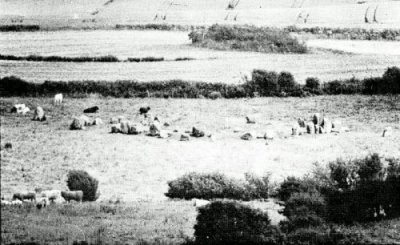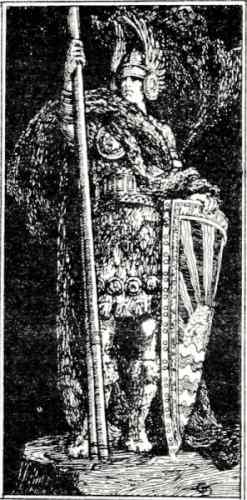Prehistoric people in Lecale can be classified into three Ages; Stone, Bronze and Iron, according to the materials they used for their tools and weapons.
Stone Age people
About 9000 years ago, some 2000 years after the ice had retreated, nomadic hunter-gatherers, who probably arrived from the British mainland, hunted wild pig and salmon, using harpoon-like implements pointed with sharp flints. Although little remains of their presence, one of their camps with a kitchen midden was excavated near Comber.
Sometime after 4000 B.C. Neolithic farmers brought a whole new way of life, carrying seed-corn and young animals, cattle, pigs and goats. They built small timber houses and made more efficient arrowheads, spearheads, knives and axes. They cleared the forests, planting regular crops of wheat and barley, thus establishing a way of life which has persisted - with some slight technological changes - to the present . They made pots and bowls to store liquids and grain and they buried their dead in huge stone tombs.
These megalithic tombs and stone circles still mark the landscape. In 1946 at Audleystown a farmer discovered a large cairn. In the long, neatly built building containing a gallery with four chambers, were the bones of some seventeen bodies. In a single court grave at Ballyalton, about three miles east of Downpatrick were found Neolithic shards and an open bowl, ornamented of twisted cord decoration, now known as the Ballyalton bowl. The bones of at least seven persons were found.
 One of the most impressive of the local megalithic remains is Ballynoe stone circle. On low-lying ground, surrounded by hills, this circle, about 110 feet across, consists of about 50 huge stones, some still upright, others lying flat. Few of the stones show more than four or five feet above the present ground surface. A smaller, not quite completed oval of 26 stones embraces a stone cairn, covered by earth, lying on an east-west axis, with a chamber at each end. Outside the circle there are eight separate monoliths.
One of the most impressive of the local megalithic remains is Ballynoe stone circle. On low-lying ground, surrounded by hills, this circle, about 110 feet across, consists of about 50 huge stones, some still upright, others lying flat. Few of the stones show more than four or five feet above the present ground surface. A smaller, not quite completed oval of 26 stones embraces a stone cairn, covered by earth, lying on an east-west axis, with a chamber at each end. Outside the circle there are eight separate monoliths.
The Bronze Age
Evidence of the first inhabitants of Downpatrick was uncovered by chance in 1962 during the construction of the Meadowlands housing estate, off Church Street. Arthur Pollock, Verger of Down Cathedral and local amateur archaeologist, recovered dark, charcoal-stained soil and sherds of pottery. This was confirmed by archaeologist, Dudley Waterman, to be of the Cordoned Urn type. He dug a cutting between six and twelve feet wide and 140 feet long and uncovered the remains of two round houses, respectively twenty feet and thirteen feet in diameter, and a number of pits and hearths, which had not all necessarily been in use at the same time. Other finds suggested that that the dwellers in these huts may have kept livestock. The charcoal found was carbon dated between 1845 BC and 1315 BC He concluded, by study of the water levels and contours, that this 'village' had on the edge of a shallow lake of water from the river Quoile, extending over the low lying area of the present Meadowlands estate.
In 1954 Arthur Pollock, while digging a new grave in the Cathedral uncovered ten golden bracelet, half of another one and part of a heavy neck ring. They were dated between 600 BC and 300 BC. In June 1956, Arthur struck gold again, as before while digging a new grave. Close to his original find he uncovered four pennannular gold bracelets. The evidence indicated that the material had been deliberately concealed and both of the discoveries were declared to be Treasure Trove
The Iron Age
In Lecale, as in the rest of Ireland, the Iron Age, from the middle of the last millennium BC to the first centuries AD is something of an archaeological 'dark age'.
The remains of this period are mostly weapons, slashing swords and long-shafted spears. The most important remains of these centuries are the tens of thousands of raths which can be seen all over Ireland. The few which have been excavated draw a picture the farmers of Lecale living in wattle-and-daub farmhouses inside raths. This way of life, where the farmer and his animals live in close association, but distanced from other farmers by the fields they own, continued up to the twentieth century.
Throughout the Irish landscape are a great many hill-forts, enclosures and promontry forts, all of which, needed a settled, organised society with large numbers of people to build and which therefore must be associated with leaders with the power to organize the building. Dun Lethglaise (one of the earliest names of Downpatrick) is one of the six 'royal' sites of Ireland named in the early literature, sites, at Tara, Emain Macha, Clogher, Dun Ailinne and Cornaskee, This contributes to view of a society highly organized for the construction of the earthworks and the protection of the cattle, pigs and horses.
 Can we imagine the chieftain of the tribe, perhaps called Celtchair, with his warriors, law-givers, druids, poets, bards and craftsmen, living on the hill called Dun Lethglaise. From the door of his wooden hall, much used for communal feasting and the story telling that accompanied it, he could overlook the green countryside and the spreading waters of the river Quoile. He may have been Celtchair described in the Tain Bo Cualnge as -
Can we imagine the chieftain of the tribe, perhaps called Celtchair, with his warriors, law-givers, druids, poets, bards and craftsmen, living on the hill called Dun Lethglaise. From the door of his wooden hall, much used for communal feasting and the story telling that accompanied it, he could overlook the green countryside and the spreading waters of the river Quoile. He may have been Celtchair described in the Tain Bo Cualnge as -
'...a wrathful, terrible, fearsome man. He was big nosed, big eared and with prominent eyes. Rough grizzled hair he had. A striped cloak he wore and in that cloak over his breast an iron stake which reaches from shoulder to shoulder. A rough, plaited shirt next to his skin. Along the side of his back a sword of refined iron, tempered seven times in the heat. A brown mound, to wit, his shield, he carried. A great grey spear, with thirty rivets through its socket, in his hand. He is half a battle (in himself) he is a leader of strife, he is a chief in valor. That was Celtchair Mor mac Uthechair from Lethglais in the north.'
Acknowledgements: 'St Patrick's Town' by Anthony Wilson
'Lecale Miscellany-No 18' Journal of the Lecale Historical Society